An essential part of Bhutan’s cultural heritage are the thirteen traditional arts and crafts that have been practiced from time immemorial. These arts were formally categorized during the reign of Gyalse Tenzin Rabgay, the fourth temporal ruler of Bhutan. The thirteen arts and crafts are known as ‘Zorig Chusum’ and categorized as follows:

The textile industry is an integral part of Bhutanese life and culture. As such the art of weaving is widely practiced. Women of eastern Bhutan are skilled at weaving and some of the most highly prized textiles are woven by them. In the past, textiles were paid as a form tax to the government in place of cash and people from western Bhutan travelled all the way to Samdrup Jongkhar to acquire often bartering for woven textiles. Bhutanese textiles are woven from cotton, raw cotton and silk with intricate motifs woven into the cloth.
Khoma village in Lhuentse is famous for Kushithara, while Rahi and Bidung are known for bura textiles, namely Mentsi Matha and Aikapur. One type of cotton fabric woven in Pemagatshel is the Dungsam Kamtham. Which lends its name to the village Decheling in Samdrup Jongkhar and Adang village in Wangdue Phodrang is known for textiles such as Adang Mathra, Adang Rachu and Adang Khamar while the Bumthaps in central Bhutan are known for Bumthap Mathra and Yathra, both textiles woven out of Yak hair and sheep wool. It’s interesting to note that the people of Nabji and Korphu in Trongsa are known for textiles woven out of nettle fibers. Weaving is also a vocation amongst the Brokpas of Merak and Sakteng.
Men contribute in spinning yak hair and sheep wool into thread There are four types of looms that are used by Bhutanese weavers. They are the blackstrap loom, the horizontal fixed loom, the horizontal-framed loom and the card loom. The predominant type is the indigenous back-strap loom. It is used mostly by weavers from eastern Bhutan and is set up on porches or in thatched sheds to protect weavers and the cloth from the sun and rain. The horizontal frame loom and the card loom were brought into Bhutan from Tibet and are still used today.
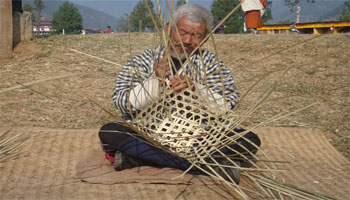
Most of the forests in Bhutan are richly stocked with bamboos and canes of various species. Taking advantage of these abundant natural resources, the Bhutanese people have mastered the skill of weaving cane and bamboo products. Widely known as Tshar Zo, this art is spread throughout the .country and products such as baskets, winnowers, mats, containers known as Palangs and bangchungs are all made. The people of Kangpara in eastern Bhutan and the Bjokaps of Central Bhutan are the pioneer’s and masters of this craft. Their products are now sold to tourists earning them additional income and keeping this craft alive.
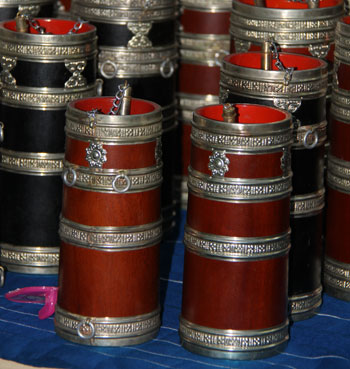
The art of wood turning is known as Shag-Zo and is traditionally practiced by the people of Trashiyangtse in eastern Bhutan.
The master craftsmen of this vibrant art are known as Shag Zopa. They are famed for the wooden cups and bowls traditionally known as dapas and phobs. These wooden bowls are made of special wooden knots known as Zaa and are highly valued. Until the advent of steel and brass, these bowls were widely used by the Bhutanese. Today they are typically sold at craft markets and offered as gifts.
Khengkhar is a small village in eastern Bhutan where the villagers are well known for producing traditional wooden wine containers known as Jandup.
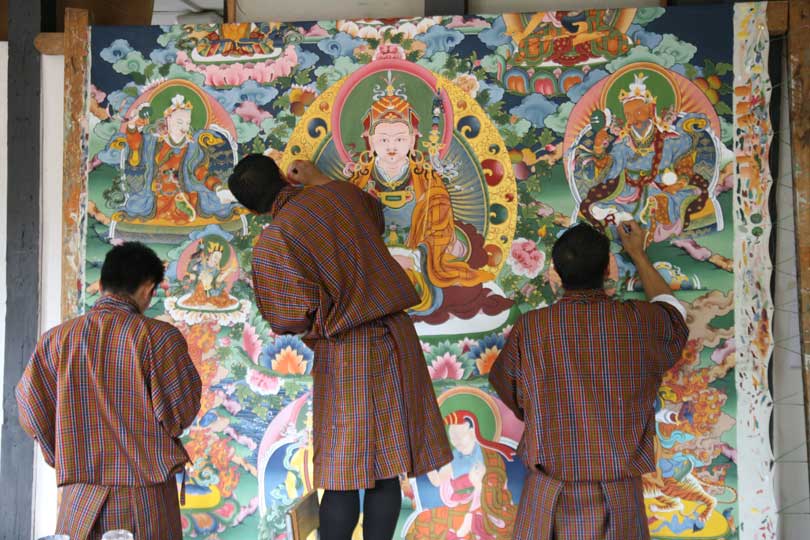
Bhutanese paintings are quintessential of the arts and crafts tradition known as Lha-zo.
An ancient art that has been practiced since antiquity, paintings captures the imagery of the Bhutanese landscape. Master painters are known as Lha Rips and their work is apparent in every ….architectural piece from the massive Dzongs to glorious temples and spiritual monasteries and even in modest Bhutanese homes.
Paintings and their varied colors and hues epitomize the Bhutanese art and craft. A perfect example of this art form are the massive thongdrols or thangkas, huge scrolls depicting religious figures that are displayed during annual religious festivals. The mere sight of these enormous scrolls is believed to cleanse the viewer of his sins and bring him closer to attaining nirvana. Thus, it brings merit not only to the believers but for the painters as well.
Young novices are taught by the master Lha Rips. The materials used in Bhutanese paint are the natural pigmented soils that are found throughout the country. These natural soil pigments are of different colours and are named accordingly. The black lumps of soil is known as ‘sa na’, and red lumps as ‘Tsag sa’, for instance.
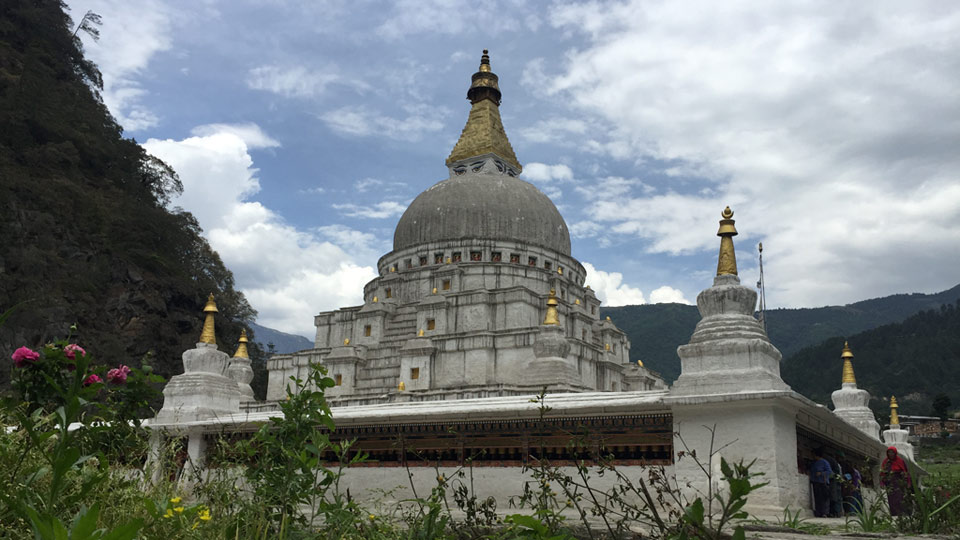
Do zo is the ancient craft of masonry, a trade which is still practiced today.
In Bhutan, temples, Dzongs, Chortens (or stupas) and farm-houses are all constructed using stone. Classic examples of stone work are those of Chorten Kora in Tashiyangtse in eastern Bhutan and Chendebji chorten in central Bhutan.
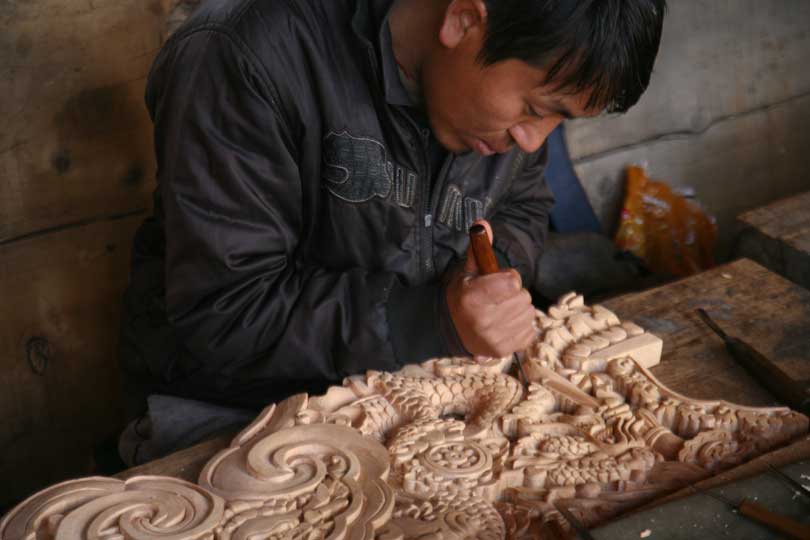
Par zo is the art of carving and another traditional Bhutanese art form that has been perfected over generations.
Major carvings are carried out on stone, wood and slate. The traditional designs crafted on these materials create beautiful and distinctive art works unique to the Land of the Thunder Dragon.
As Bhutan has been blessed with an exceptionally abundant variety of trees, woodcarving is seen in a variety of forms. The wooden masks featured during the annual religious festivals (Tsechus) as well as the many traditional motifs that are engraved on the Bhutanese houses and on Dzongs are all carved out of wood.
A unique wood carving that draws attention from visitors are the phalluses of various sizes and shapes that are hung on the four corners of traditional Bhutanese houses and placed over the main entrance door. These carved wooden phalluses are also wielded by the Acharyas- the clowns during religious festivals as a sign to bless spectators and drive away their evils and misfortunes.
The art of slate carving is also practiced and the master craftsmen are known as Do Nag Lopens. Slate which is found in both Western and Eastern Bhutan are used in such carving. While slate carving is not as diverse as stone or wood works, it is found in many religious scriptures, mantras and deific engravings and Slate carvings are quite common place in religious places such as Dzongs, temples and Chortens. Stone carving while less evident, is found in huge grinding mills that are still used by people in the far flung villages of Bhutan. One can also come across hollowed–out stones used for pounding grains and troughs for feeding cattle and horses.

Jim zo or clay work is an ancient craft that has been practiced and passed down over the centuries. This art form preceded other sculpture works such as bronze and other metal works. Statues of deities, gods and goddesses and other prominent religious figures exemplify clay work in Bhutan.
Every monastery, temple and Dzong in the country has intricately molded clay statues from where pilgrims and devout Buddhists draw their inspiration. Master sculptors are known as Jim zo lopens and impart their skills to young novices over several years of rigorous training. In addition to sculpting clay statues, the tradition of crafting clay pottery is still alive. However, these days most of the potteries are being used as show pieces.
While the art of modeling statues is confined to men, the art of pottery is normally reserved for women. While there are three distinctive types of clayware: earthenware, stoneware and the china-clayware, in Bhutan, we find only earthenware. When crafting clay pottery, success depends upon the composition of the clay, the crafter’s skill in shaping the clay and baking the material to the correct temperature.
The baked items are then coated with lac to render them waterproof. While this tradition is nearly dying out in some areas, the women of Lhuentse and Paro actively practice it and are still keeping the venerable art form alive.
Between the Stone Age and the Iron Age we have ….the Bronze Age around about 3500 BC. Bronze was commonly used to cast containers such as cups, urns, and vases. People also shaped bronze into weapons and armor such as battle-axes, helmets, knives, swords and shields. Bronze casting in Bhutan was introduced only in the 17th century and was mainly spread through the visiting Newari artisans that came from Nepal. The Newars were first invited by Zhabdrung Nawang Namgyal to cast bronze statues and religious items such as bells and water offering bowls. It was through these artisans that the art was introduced and today, quite a few Bhutanese practice bronze casting.
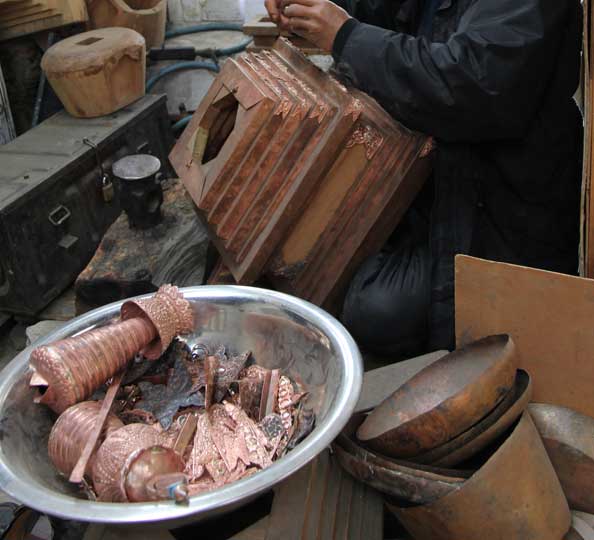
The art of iron work is known as Gar-zo and blacksmithing in Bhutan began sometime in the late 14th century. It is believed that it was introduced by a Tibetan saint known as Dupthob Thangtong Gyalpo. He is revered by the Bhutanese people as a master engineer for his skill in casting iron chains and erecting them as bridges over gorges. He is supposed to have built eight suspension bridges in Bhutan. You can still see one of the bridges crossing over the Paro Chu, on the road from Paro to Thimphu, and linking the highway to the famous Tachog lhakhang. The remains of another bridge can be viewed at the National Museum in Paro.
While blacksmithing is almost a dying art, you can still find the original Tibetan settlers in Trashigang practicing this skill.
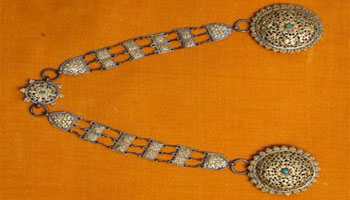
The vibrant craft of traditional ornament making is Still designed today and is known as Troe Ko. Its products are widely used by Bhutanese women. A master craftsman skilled in shaping beautiful ornaments is regarded as Tro Ko Lopen. Using precious stones and metals such as corals, turquoise, silver and gold, these master craftsmen create all manner of ornaments and implements including necklaces, bangles, earrings, rings , brooches, amulets to contain ritual objects, traditional containers to carry the much chewed beetle nut, ritual objects and much more.
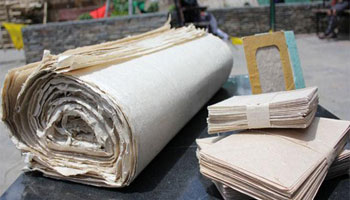
Paper-making is another art that has deep roots in Bhutan. People engaged in producing the traditional Bhutanese paper or De zo are known as Dezop. This traditional paper is made from the bark of the Daphne tree and was widely used in the past. Most religious scriptures and texts were written on Dezho using traditional Bhutanese ink or occasionally in gold. While the presence of readily available modern paper has overtaken the market, people still produce and use Desho as carry bags, wrapping for gifts and envelopes. The art still continues in Trashiyangtse where the raw material is readily available.
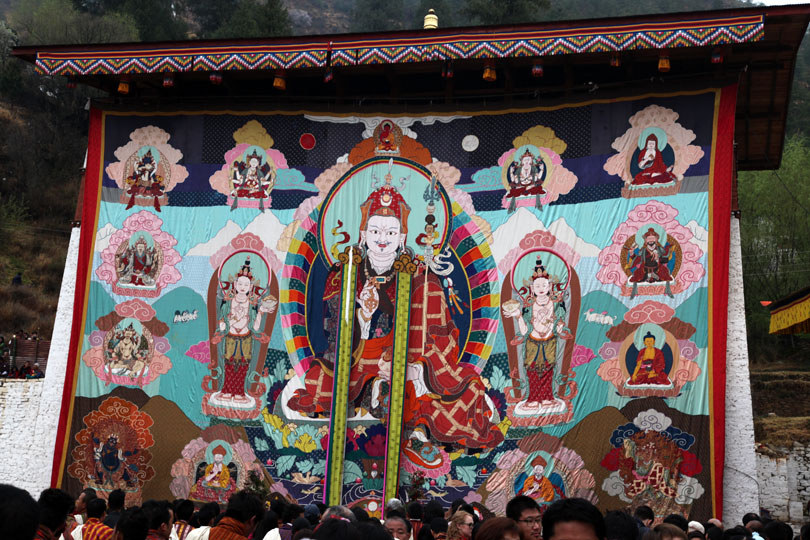
Tzhem zo or the art of tailoring is a popular art amongst the Bhutanese. This art can be broadly classified as Tshem Drup, the art of embroidery, Lham Drup the art of appliqué and Tsho Lham, the art of traditional Bhutanese boot making. The art of embroidery and appliqué are normally practiced by monks. Using this art they produce large religious scrolls known as Thongdrels and Thangkas that depicts Gods and Goddesses, deities and saints.
Traditional boot making is normally the work of Bhutanese lay men. These boots, worn by officials during special functions and gatherings are made of leather and cloth. While boot making is an old craft, its origin is unknown. Special craftsmen in the villages also make simple boots from uncured leather. However, this is a vanishing practice but with the government’s support it has seem a recent revival in the kingdom’s urban centers.
The third category is tailoring. These craftsmen are skilled at sewing the traditional Bhutanese garments known as Gho and Kira.
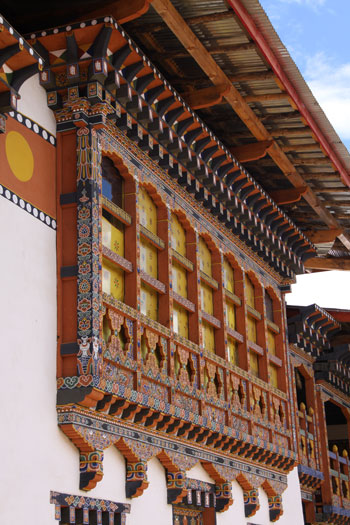
Shing-zo or carpentry plays a major part in the construction of Bhutan’s majestic fortresses or dzongs, temples, houses, palaces and bridges.
